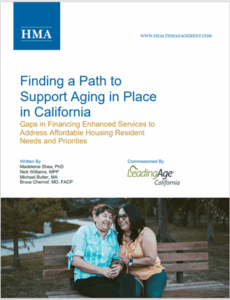Most older adults want to remain at home as they age, yet rising costs of health care and long-term services and supports (LTSS), also known as long-term care, and a fragmented care delivery system create barriers to doing so. This is particularly true for older adults with low incomes, who often experience complex care needs and chronic conditions. Efforts to integrate care for this population (e.g. coordinating Medicaid and Medicare services, integrating health care and housing) have had varying levels of success, and many remain siloed or face issues of scalability.

LeadingAge California, with support from The SCAN Foundation and California Health Care Foundation, explored the scalability and sustainability of the California Integrated Care at Home (CICH) model to better support access to services. CICH includes placing a nurse and team of community health workers at affordable senior housing communities to support participants in activities like accessing health care and community-based services, preparing for a hospital or short-term rehab admission, and managing medications. The study included:
- A survey of older adults in senior housing to learn what mattered most to them regarding their health care
- Exploration of opportunities to braid funding sources such as Medi-Cal (California’s Medicaid program), Medicare, housing supports, and city/county funding.
The report offers recommendations for state leadership and policymakers on the design and sustainability of the CICH model. This report will be useful for advocates and policymakers alike to learn about the landscape of integrated LTSS, health care, and housing programs and the viability of the CICH model in California.
Read the report here. To learn more about the CICH model, visit this website.
